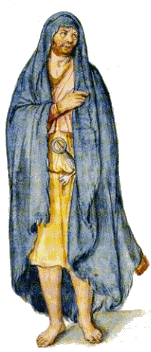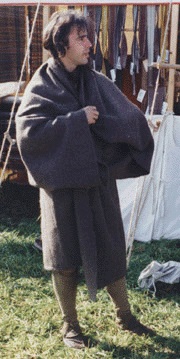|
-
8th April 21, 09:22 PM
#1
Historical Great Kilt
I’ve seen Great Kilts advertised measuring anywhere from 4 to 9 yards, which got me wondering- how large were these kilts historically?
-
-
9th April 21, 11:27 AM
#2
The tartan fabric was woven on a narrow loom, often with the pattern calculated so that when the piece was cut into two lengths it could be joined and the sett would be continuous.
References - I am assuming there are references, to 9 yards would mean that length of narrow fabric, which would make 4 and 1/2 yards when joined up.
Having tried out a great kilt I found that in today's environment it was great for sweeping low level tables, catching on chair arms and backs and on door handles and knobs.
It was very soon converted into a dressing gown.
I presume to dictate to no man what he shall eat or drink or wherewithal he shall be clothed."
-- The Hon. Stuart Ruaidri Erskine, The Kilt & How to Wear It, 1901.
-
The Following 4 Users say 'Aye' to Pleater For This Useful Post:
-
10th April 21, 09:33 AM
#3
Our Tartan historian Peter, tells us that there are simply no historical examples of what today is called a "Great kilt". None, not even in museums.
So what are sold as "great kilts" are some individual's interpretation, or guess, of what it "may" have been. The truth is, we simply don't know.
It may have been a heavy blanket like the Irish Brat -

Or like an Hudson's Bay trade or army blanket, worn as what is historically documented as a matchcoat -

You can see examples of this style of garment in just about every human culture. Some are very, very old and yet amazingly decorative-
]

And some are worn pretty close to what we think of as great kilt. -

So I would not spend too much time worrying over being 100% historical accuracy and just enjoy the garment. No one can tell you that you are wrong.
-
The Following User Says 'Aye' to Steve Ashton For This Useful Post:
-
12th April 21, 10:58 PM
#4
 Originally Posted by Steve Ashton

Our Tartan historian Peter, tells us that there are simply no historical examples of what today is called a "Great kilt". None, not even in museums.
Steve, not quite, what I've said it that there are no complete surviving examples. There are quite a few pieces of what were likely to have been a Belted Plaid, mostly small pieces but the odd larger section survives. Probably the most complete example is a plaid that was cut in halved and used as curtain at Dunollie House, Oban. It is discussed here.
-
The Following User Says 'Aye' to figheadair For This Useful Post:
-
13th April 21, 08:40 AM
#5
Here are Scottish Highlanders wearing the breacan-an-feilidh in 1631, serving as soldiers on the Continent, drawn by a German artist.

I would think that the artist had never seen such clothing, and it's nice that he took care to show the various ways it was worn.
Seems that the artist wasn't quite sure what he was seeing, either that or Highlanders would wrap their plaids around their legs as improvised trousers.
Such confusion about the structure of the breacan-an-feilidh continues to this day! Costumers for various modern films have evidently seen images of both the philamore, and the philabeg worn with separate plaid wrapped around the body. Not realising that they were seeing two distinct forms of dress, the costumers conflated them, devising the goofy garments worn in Rob Roy and Braveheart, essentially a little kilt with attached long plaid that goes diagonally across the body.
Last edited by OC Richard; 13th April 21 at 08:51 AM.
Proud Mountaineer from the Highlands of West Virginia; son of the Revolution and Civil War; first Europeans on the Guyandotte
-
 Posting Permissions
Posting Permissions
- You may not post new threads
- You may not post replies
- You may not post attachments
- You may not edit your posts
-
Forum Rules
|
|
Bookmarks